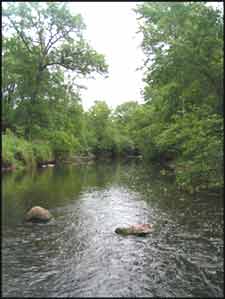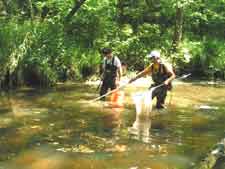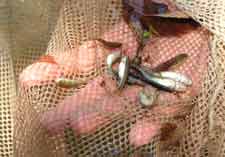Brenda Asmus
MS Thesis Project
Introduction
Channel stability has long been considered integral for maintaining healthy biotic communities, although empirical evidence of that relationship is limited (Maul et al. 2004; Sullivan et al. 2004). It is suspected that unstable banks can deliver excess sediment to streams and exacerbate conditions leading to water quality degradation and federal 303d listing for total suspended solids (TSS), turbidity, low dissolved oxygen, temperature, and impaired biota.
My project is to assess whether or not physical indicators of channel stability could be used to predict biotic communities using an Index of Biotic Integrity (IBI) for fish and macroinvertebrates. If a strong relationship between stream stability and biota is demonstrated, physical indicators of channel condition could be useful for water quality managers involved in assessing the hydrologic stability and physical integrity of streams for biological monitoring, reference stream selection, and TMDL problem investigations.
Research Questions
- Does channel stability influence aquatic community health?
- Does channel stability or habitat quality better predict biotic community health?
- Are fish or macroinvertebrates more sensitive to conditions of channel instability?
Research Hypotheses
- Biotic communities will respond to a gradient in channel stability; stable channels will derive higher IBI scores than unstable channels.
- Channel stability will be a better predictor of aquatic health than habitat quality.
- Macroinvertebrates will be more sensitive to gradients in channel stability than fish.
Materials and Methods
Study Regions
Two river basins in Minnesota were selected for this study: the Redwood River Basin in the southwest and the Snake River Basin in the northeast. These two basins were chosen based on differences in ecoregion and land use.
Site Selection
Initial site selection criteria included:1) Selecting sites which would cover a range in IBI scores previously collected by the Minnesota Pollution Control Agency (MPCA), 2) cover a range in gradient and sinuosity, 3) both natural and channelized stream conditions, 4) wadable, and 5) accessible in terms of both landowner permission and distance from access point to site.
Field Data Collection
University of Minnesota (UMN) field teams collected Geomorphology and Biology data from 28 stream reaches in 2005 and 2006; supplemental biology data was also collected by the Minnesota Pollution Control Agency (MPCA) in 2001, 2003 and 2006.
In summers 2005, two teams were employed for data collection: the biology team collected fish community, chemistry, and habitat data, and the geomorphology team collected channel dimensions, longitudinal profile, water gradient, pebble counts, and channel stability assessments. Channel dimensions include: bankfull width and mean bankfull depth, entrenchment ratio (flood plain width to bankfull width). Channel stability assessments included Pfankuch’s (1975) Stream Reach Inventory and Channel Stability Evaluation (Pfankuch Assessment). Channel Evolution stages were determined in the field and validated with cross-sectional dimensions. Channel dimensions, water gradient, and mean substrate size (D50) were used to classify streams using the Rosgen Classification system (Rosgen 1996). Additional data was also collected in 2006 to increase the sample size in each basin (n=14) and validate field indicators of bankfull as determined by regional hydraulic curves.
Data Analysis
Objective 1
To investigate the relationship between stream stability and biota.
- Assess stream stability state using commonly applied methods (Rosgen Stream Assessment (1996); Stream Reach Inventory and Channel Stability Evaluation (Pfankuch, 1975); and the Channel Evolution Model (CEM; Schumm et al. 1984).
- Sample fish and macroinvertebrate communities using protocols employed by the Minnesota Pollution Control Agency (Barbour et al. 1999, MPCA 2002).
- Test the relationship between Pfankuch Assessment Inverse score and IBI using Spearman Correlation. Additionally, test individual metrics comprising the Pfankuch Assessment and IBI for relationships using Nonmetric Multidimensional Scaling (NMS).
Objective 2
To determine whether or not aquatic habitat or stream stability state is a better predictor of biotic health as measured with the Index of Biotic Integrity (IBI) for fish and macroinvertebrates in low gradient Midwestern streams in each study basin.
- Complete habitat assessments during sampling visits using a modified Qualitative Habitat Assessment Index (QHEI) for fish and the Habitat Assessment for Low Gradient Streams (HA-LG; Barbour et al. 1999) for macroinvertebrates.
- Use fish and macroinvertebrate data collected to compute IBI scores using metrics developed specifically for each basin and drainage area size class (Chirhart 2003, Niemela and Fiest 2000).
- Use habitat and channel stability scores as predictor variables and test with IBI scores for fish and macroinvertebrates using Spearman Correlation. Additionally, test individual metrics comprising the Pfankuch Assessment and IBI for relationships using Nonmetric Multidimensional Scaling (NMS).
Objective 3
To determine whether or not fish or macroinvertebrates appear to be more responsive to gradients in stream stability.
- Use IBI scores for fish and macroinvertebrates; compare results from objective 1.
Select References
Barbour, M.T., J. Gerritsen, B.D. Snyder, and J.B. Stribling. 1999. Rapid Bioassessment Protocols for Use in Streams and Wadeable Rivers: Periphyton, Benthic Macroinvertebrates and Fish, Second Edition. EPA 841-B-99-002. U.S. Environmental Protection Agency; Office of Water; Washington, D.C.
Chirhart, J. 2003. Development of a Macroinvertebrate Index of Biological Integrity (MIBI) for Rivers and Streams of the St. Croix River Basin in Minnesota. Minnesota Pollution Control Agency Biological Program. St. Paul, MN.
Maul, J. D., J. L. Farris, C. D. Milam, C. M. Cooper, S. Testa III, and D. L. Feldman. 2004. The influence of stream habitat and water quality on macroinvertebrate communities in degraded streams of northwest Mississippi. Hydrobiologia. 518: 79-94.
Minnesota Pollution Control Agency (MPCA). 2002. Fish Community Sampling Protocol for Steam Monitoring Sites. Biological Monitoring Program. St. Paul, MN. Revised 2002.
Minnesota Pollution Control Agency (MPCA). 2001b. Physical Habitat and Water Chemistry Assessment Protocol for Wadeable Stream Monitoring Sites. Biological Monitoring Program. Revised 2002. St. Paul, MN.
Niemela, S. and M. Fiest. 2000. Index of Biotic Integrity (IBI) Guidance for Coolwater Rivers and Streams of the St. Croix River Basin in Minnesota. Minnesota Pollution Control Agency Biological Monitoring Program. St. Paul, MN
Pfankuch, D. J. 1975. Stream Reach Inventory and Channel Stability Evaluation. USDA Forest Service, R1-75-002, U.S. Government Printing Office #696-260-200, Washington, D.C.: 26 pp.
Rosgen, D. L. 1996. Applied River Morphology. Wildland Hydrology, Fort Collins, CO.
Schumm, S. A., M. D. Harvey and C. C. Watson. 1984. Incised channels: morphology, dynamics and control. Water Resources Publications, Littleton, Colorado.
Sullivan, P., M. C. Watzin and W. C. Hession. 2004. Understanding Stream Geomorphic State in Relation to Ecological Integrity: Evidence Using Habitat Assessments and Macroinvertebrates. Environmental Management. 34(5): 669-683.




